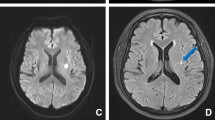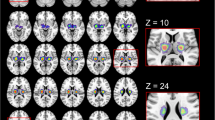Abstract
Small subcortical infarctions resulting from large-vessel disease are often observed. It is important to distinguish these from pure lacunar infarction resulting from small-vessel disease because the investigations and examinations differ. We investigated the differences on brain magnetic resonance imaging (MRI) between small subcortical ¶“lacunar-like” infarcts resulting from large-vessel disease and pure lacunar infarcts. Thirteen subjects with small lacunar-like infarcts (size < 2 cm), resulting from large-vessel disease, ¶and 30 subjects with lacunar infarcts (< 2 cm), without large-vessel disease were studied. We measured infarction size using a 1.5-T MRI device and evaluated silent subcortical hyperintensity lesions using the modified Scheltens’ score. Large-vessel lesion was confirmed by conventional angiography, duplex carotid scan, and magnetic resonance angiography. There was no difference in the mean age of the two groups. Cerebrovascular risk factors and atherosclerotic complications were also comparable for the two groups. Progressive stroke was more common ¶in the lacunar-like infarction group than in the lacunar infarction group ¶(P = 0.004). Scores for periventricular hyperintensity, white matter hyperintensity, basal ganglia hyperintensity, and total subcortical hyperintensity scores were significantly higher in the lacunar infarction group than in the lacunar-like infarction group. The difference in basal ganglia hyperintensity scores was remarkable (P = 0.001). The enlargement of the perivascular space was also significantly greater in the lacunar infarction group than in the lacunar-like infarction group. These findings seem to reflect differences in the pathogenesis of infarction between the two groups. Silent subcortical hyperintensity lesions and enlargement of perivascular space are useful for between distinguishing small lacunar-like infarct resulting from large-vessel disease and pure lacunar infarction. This may have significant implications for the management of patients with lacunar-sized infarctions. It suggests that the pathogenesis of lacunar-sized infarction is variable.
Similar content being viewed by others
Author information
Authors and Affiliations
Additional information
Received: 23 February 1999/Received in revised form: /7 December 1999/Accepted: 15 December 1999
Rights and permissions
About this article
Cite this article
Adachi, T., Kobayashi, S., Yamaguchi, S. et al. MRI findings of small subcortical “lacunar-like” infarction resulting from large vessel disease. J Neurol 247, 280–285 (2000). https://doi.org/10.1007/s004150050584
Issue Date:
DOI: https://doi.org/10.1007/s004150050584




